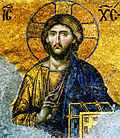Zelve Monastery
| Part of a series on |
| Eastern Christianity |
|---|
 |
|
Liturgy and worship |
|
The Zelve Monastery is a Byzantine-era monastery that was carved into the rock in pre-iconoclastic times. It is one of the Churches of Göreme, a UNESCO World Heritage Site.
Remains
The remains of the Zelve monastery complex are located on the northern slopes of Aktepe, 1 km from Paşa Bağlari and 10 km out from Göreme on the Avanos road. Zelve does not have the rich frescoes of Göreme and other Cappadocian locations. Zelve is spread out over three valleys, of which two are connected by a tunnel. The complex contains innumerable rooms and passages which also house many pointed fairy chimneys with large stems, at about 40 feet above the valley floor.
Zelve, though recently uninhabited, was an important settlement and religious area between the 9th and 13th centuries. Christians moved to Zelve during the Persian and Arab invasions.
Cappadocia's first seminaries to train priests are located here at the monastery. Dating back to the early years of monastery life in Zelve is the Direkli Church (with the famed columns). Direkli is located at the bottom of the slope. The main decorations are iconoclastic-doctrine high relief crosses. The valley also contains the Balikli Kilise (Fish), Üzümlü Kilise (Grapes) churches and the now totally collapsed Geyikli Kilise (Deer church). These churches date to the pre-iconoclastic period.
The area was inhabited until 1952, when the last inhabitants moved to the new town Yeni Zelve ("New Zelve"), 2 km away. In 1967, Zelve was turned into an open-air museum.
The area also contains houses, a tunnel joining two of the valleys, a mill (without sails), and a small mosque. Several dovecotes are found in the valley.
References
Coordinates: 38°40′N 34°50′E / 38.667°N 34.833°E